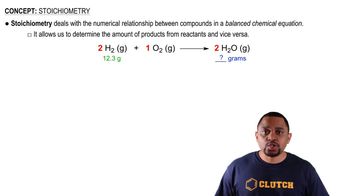Calculate the theoretical yield of product (in moles) for each initial amount of reactants.
3 Mn(s) + 2 O2(g) → Mn3O4(s)
a. 3 mol Mn, 2 mol O2
b. 4 mol Mn, 7 mol O2
c. 27.5 mol Mn, 43.8 mol O2
 Verified step by step guidance
Verified step by step guidance



Calculate the theoretical yield of product (in moles) for each initial amount of reactants.
3 Mn(s) + 2 O2(g) → Mn3O4(s)
a. 3 mol Mn, 2 mol O2
b. 4 mol Mn, 7 mol O2
c. 27.5 mol Mn, 43.8 mol O2
Zinc sulfide reacts with oxygen according to the reaction: 2 ZnS(s) + 3 O2(g) → 2 ZnO(s) + 2 SO2( g) A reaction mixture initially contains 4.2 mol ZnS and 6.8 mol O2. Once the reaction has occurred as completely as possible, what amount (in moles) of the excess reactant remains?
Iron(II) sulfide reacts with hydrochloric acid according to the reaction: FeS(s) + 2 HCl(aq) → FeCl2(s) + H2S(g) A reaction mixture initially contains 0.223 mol FeS and 0.652 mol HCl. Once the reaction has occurred as completely as possible, what amount (in moles) of the excess reactant remains?
For the reaction shown, calculate the theoretical yield of product (in grams) for each initial amount of reactants. 2 Al(s) + 3 Cl2(g) → 2 AlCl3(s) c. 0.235 g Al, 1.15 g Cl2